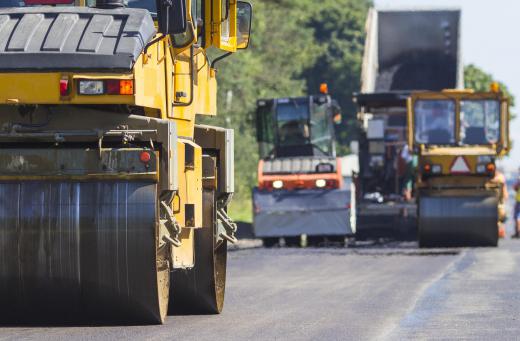A tandem roller is a piece of machinery used in paving roads and parking lots. Commonly referred to as a steam roller, the tandem roller is made up of two very heavy and unequal sized steel rollers fitted to a chassis, which is powered by steam, gasoline or diesel. The tandem roller is used to smooth out and compact asphalt or blacktop before it cools and hardens. The steel drums or rollers the machine rides on are often cooled with a stream of water in order to prevent the pavement from sticking to the rollers.
Aside from being heavy, many tandem roller units also contain a vibratory unit aboard the machine. The vibrating rollers aid in compacting the pavement as the heavy tandem roller passes over it. Working at very slow speeds, the tandem roller is a machine which requires skill in operating to assure that each pass slightly overlaps the pass prior to it. By overlapping each pass, the roller operator is able to maintain a uniform thickness to the surface and avoid any dips or high-spots.

Early versions of the roller relied on a steam-powered engine to move the large machines. This led to the common naming of the roller to be known as a steam roller. The name steam roller often finds itself attached to the machinery of today due in part to the steam that forms on the rollers as the equipment is being used. This steam is a result of the water that is used to cool and lubricate the rollers coming in contact with the very hot pavement. Steam is created by this contact and hence, the steam roller title remains intact.
While the steam propulsion system is very uncommon today, modern machinery is diesel-powered for the most part. Some smaller units use gasoline engines and battery-powered versions are beginning to emerge on some construction sites. Many models utilize two separate power systems. A diesel-powered tandem roller might also utilize a battery-powered vibratory motor.
While the huge steel rollers are very heavy all by themselves, most tandem roller units use water to add weight to the rollers. Each roller is equipped with a threaded bung which can be removed. Water is then placed inside of the roller by placing a hose into the open bung. Once the roller is filled with water, the bung is replaced and the unit becomes operational. The weight of the water aids the roller in compacting the pavement.
